neuron physiology
1/33
Earn XP
Description and Tags
Name | Mastery | Learn | Test | Matching | Spaced |
|---|
No study sessions yet.
34 Terms
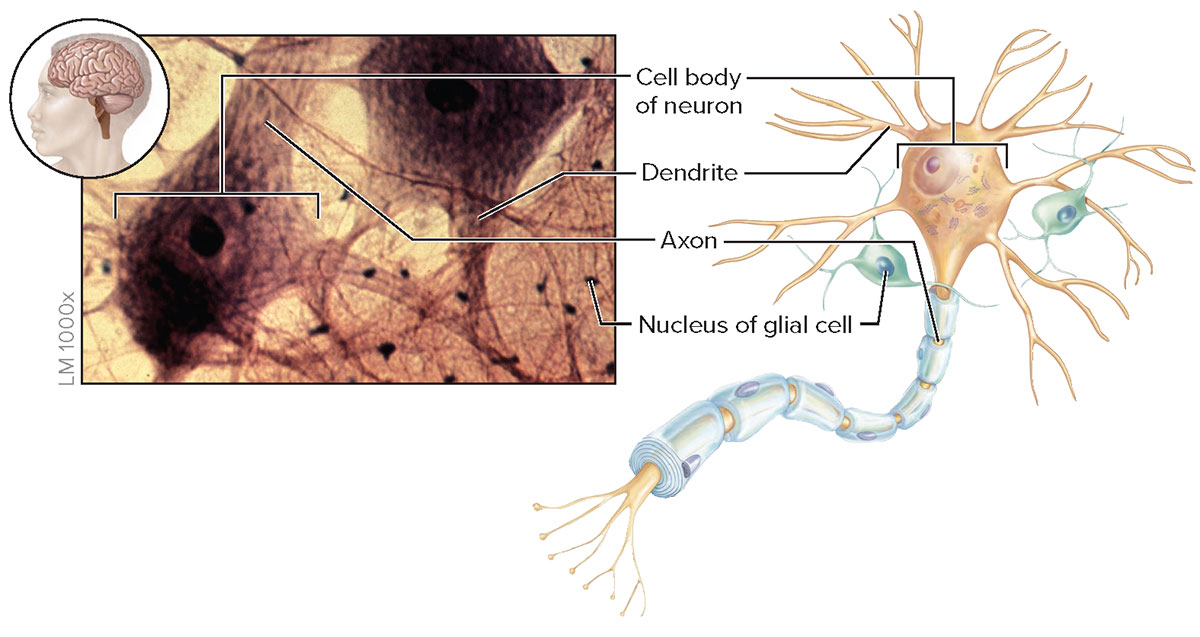
nervous tissue features
.
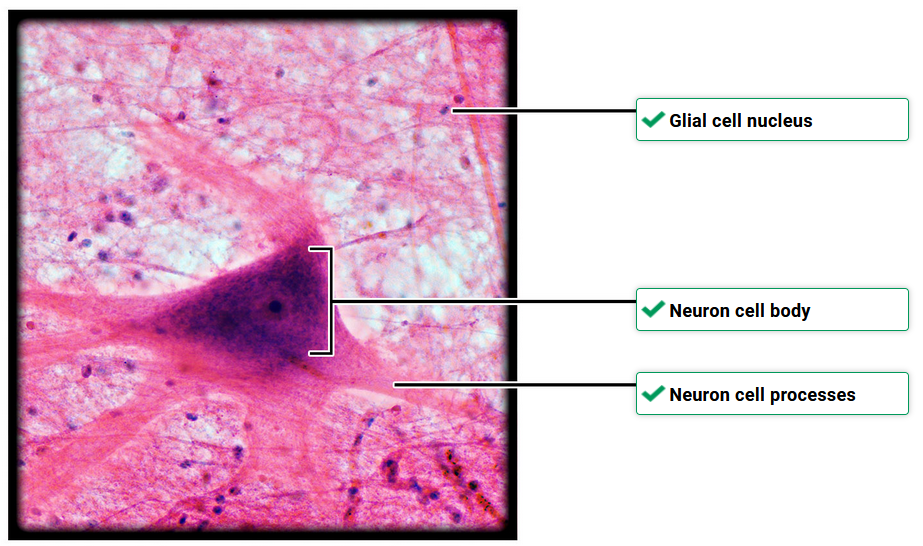
nervous tissue identification
.
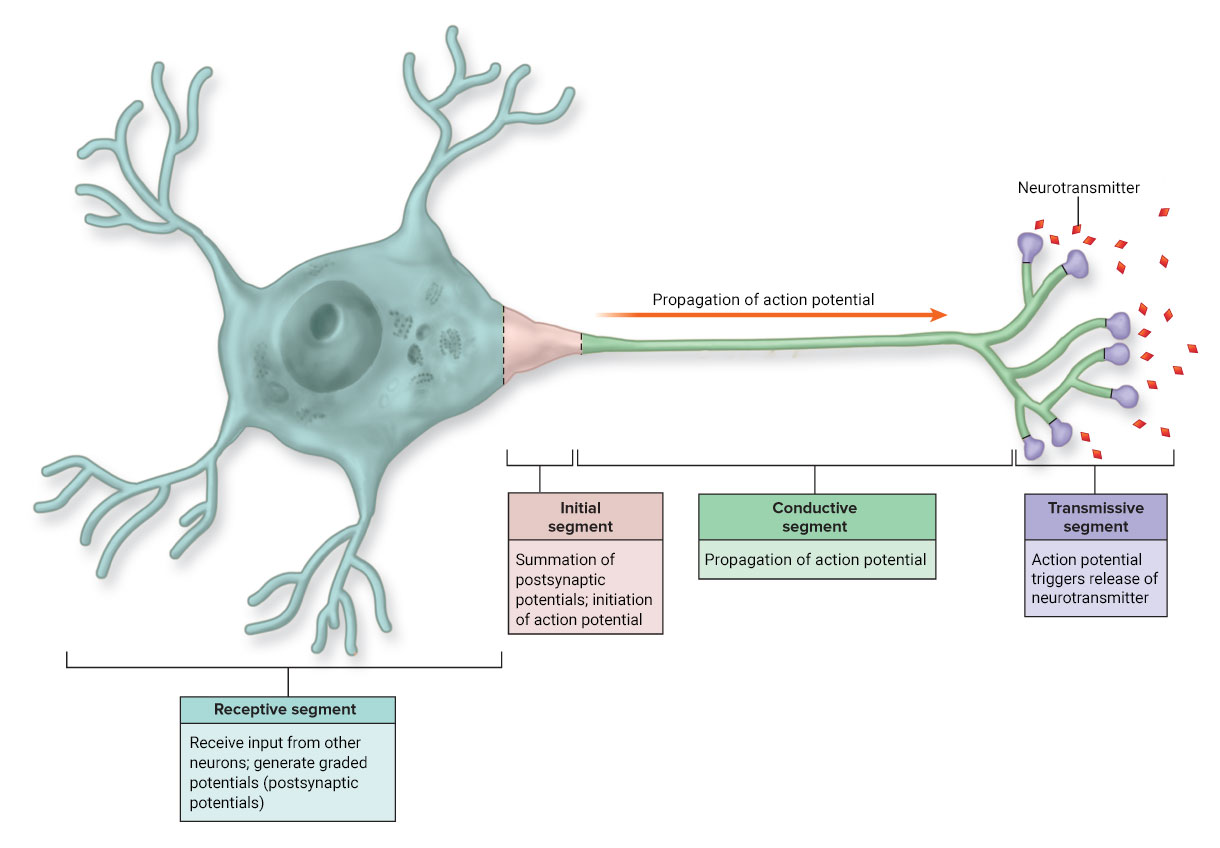
segments of neuron
.
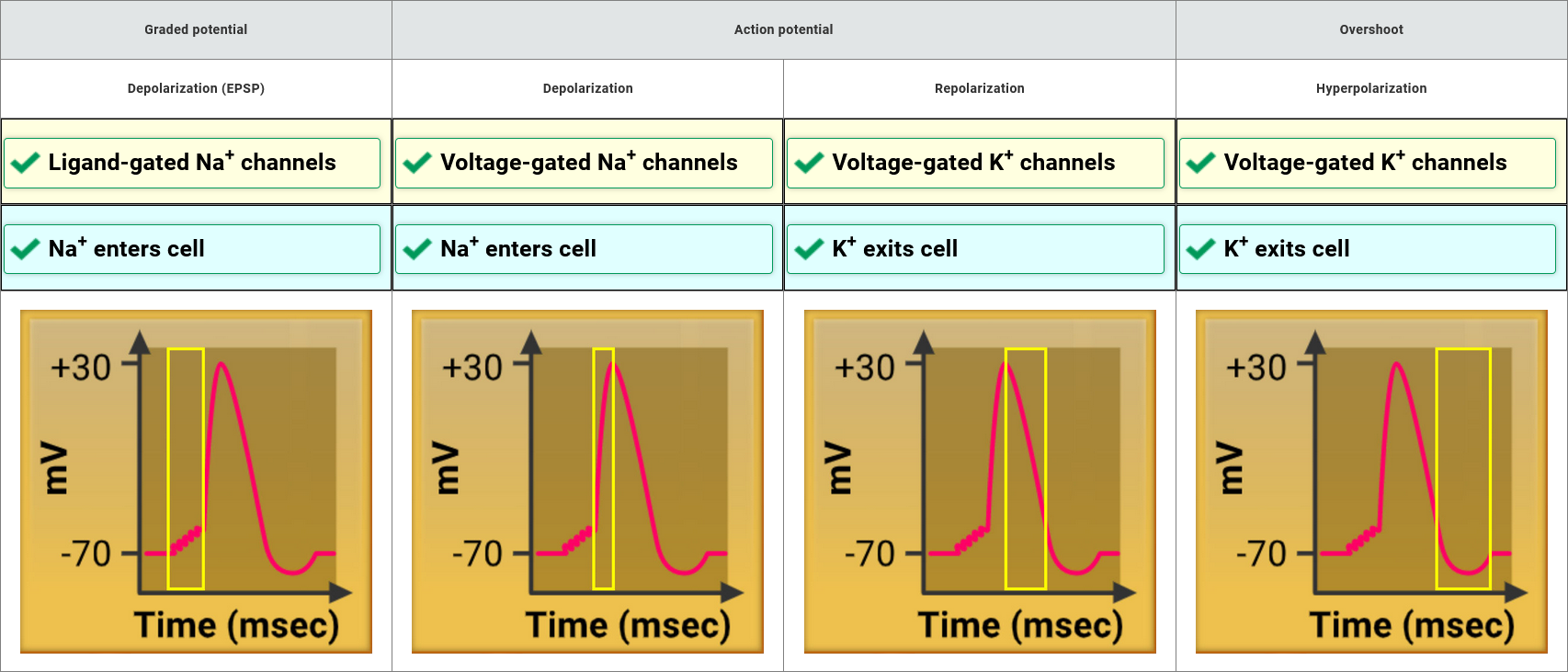
conductive segment
.
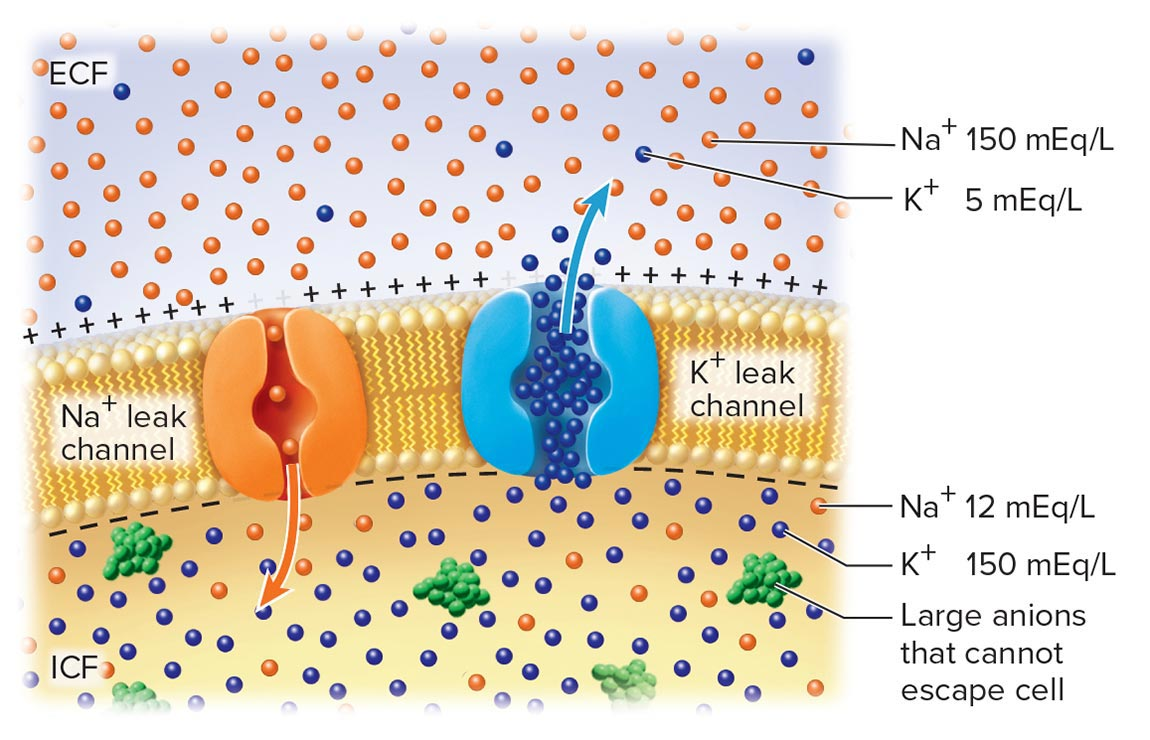
resting membrane potential
.

When the crayfish muscle fiber is at its normal resting membrane potential (about -65 mV), what is the approximate concentration of extracellular potassium? What is the concentration of sodium?
Which ion had the most influence on the membrane potential when its extracellular concentration was changed?
5 mEq/L potassium; 150 mEq/L sodium, potassium
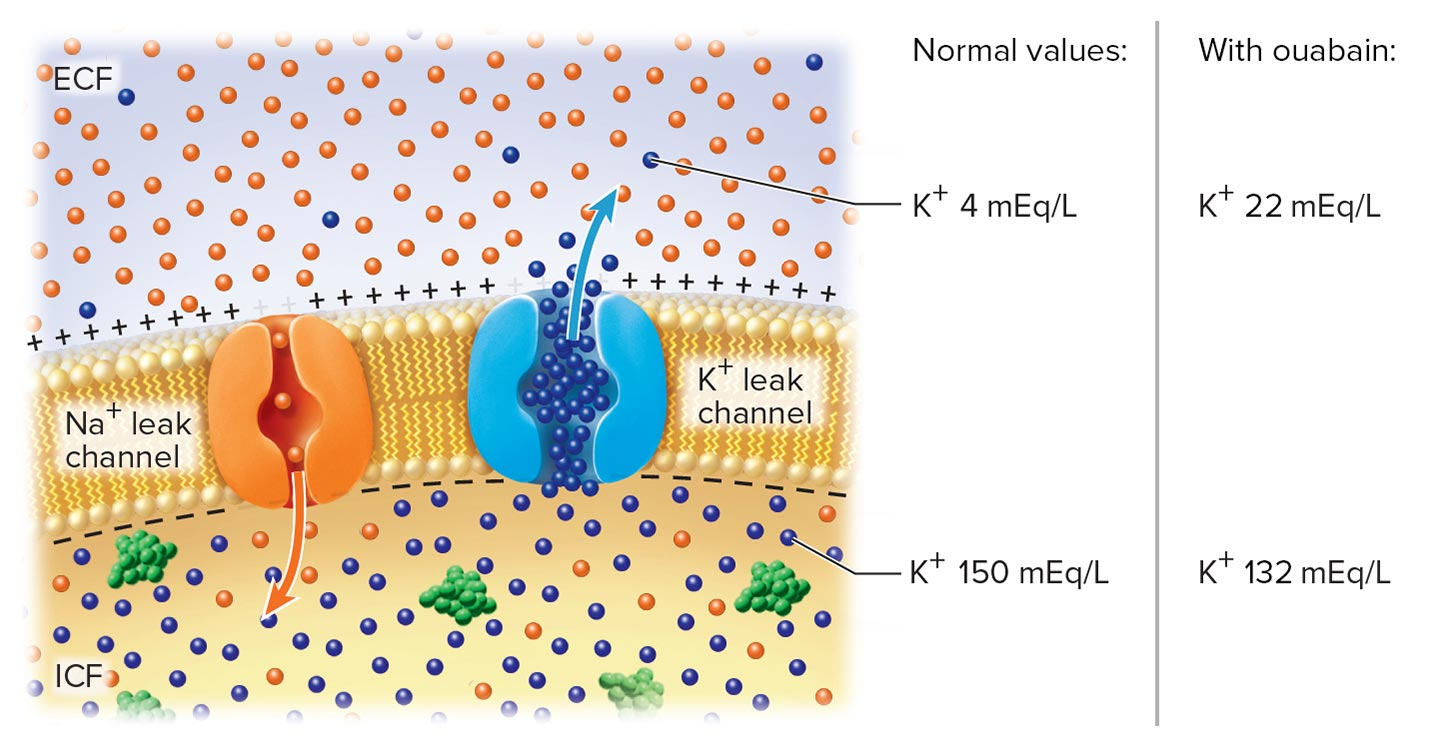
Ouabain is a drug used to treat heart failure and some arrhythmias. It inhibits normal action of the sodium-potassium (Na+/K+) pump, lessening its ability to pump Na+ out of the cell and K+ into the cell. This alters the concentrations of both ions across the membrane.
-How will ouabain affect the resting membrane potential?
-Why does elevated extracellular K+ have this effect on the membrane potential?
Abnormally high K+ concentration in the ECF would depolarize the membrane; It reduces the K+ concentration gradient across the membrane, so less K+ diffuses out of the cell & less K+ leaving the cell results in a more positive membrane potential.
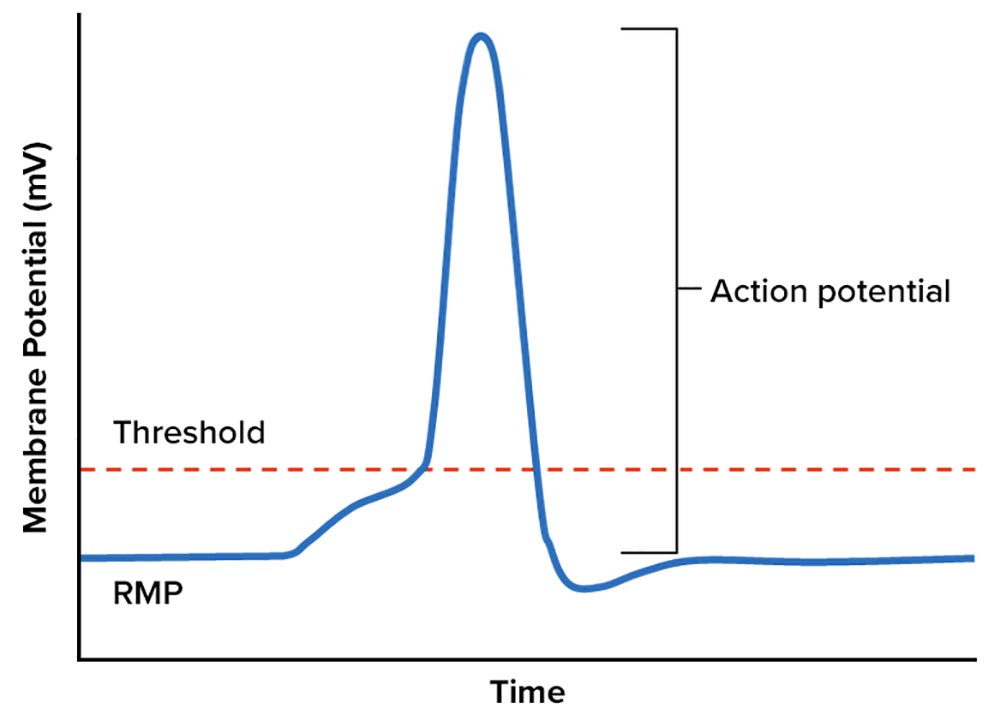
An action potential will occur when the membrane potential depolarizes to a threshold value. In muscle cells, an action potential leads to contraction of the cell. Will ouabain, inhibition of sodium potassium pump, make a muscle cell more or less likely to contract? In other words, will the muscle be hyperexcitable or have its activity depressed?
More likely to contract because the membrane is closer to threshold
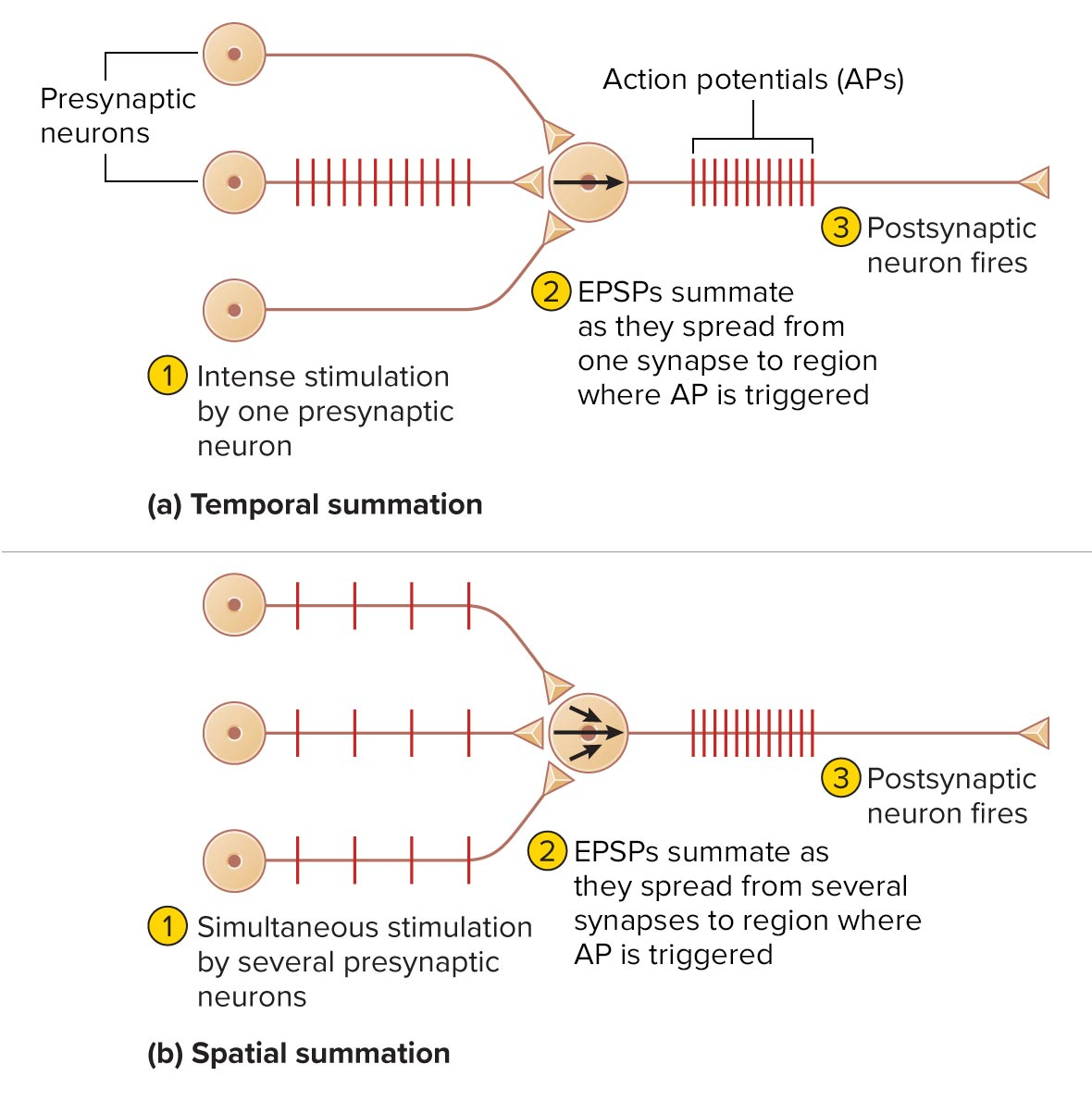
summation
.
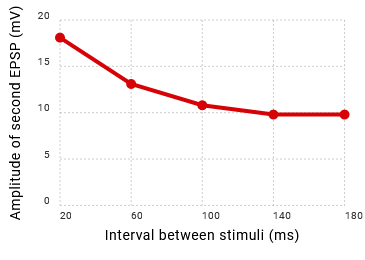
-Why does the second EPSP have a greater amplitude (strength) at a 60 ms interval compared to one at a 140 ms interval?
-Why didn't the strength of the EPSP change when the interval was decreased from 180 ms to 140 ms?
-At a single synapse, depolarization from the second EPSP was added to the depolarization from the first EPSP
-At these intervals the first EPSP fades out completely before the second EPSP forms

*What specific type of summation does this represent
spatial summation of ESPS

*What specific type of summation does this represent
temporal summation of ISPS

.

What is the threshold stimulus of the nerve? What is the maximal stimulus?
0.4 V, 1.2 V

-Refer to your data in Figure 2. Why is the second compound action potential (CAP) smaller in magnitude (strength) at a 5 ms interval compared to one at a 7 ms interval?
-At what time interval was the second stimulus delivered while all axons were within their absolute refractory period?
-Some axons are in their relative refractory period, so they are not generating action potentials
1 ms
A neurotoxin binds and disables a type of ion channel at the axon hillock, preventing depolarization of the axon hillock and axon. What specific type of channel has been affected?
voltage gated Na+ channels
What is classified as a neuron cell process?
axon & dendrite
Multipolar neurons are the most common structural type of neuron. They have ___ extensions protruding from the cell body, including: ___
numerous, multiple dendrites & a single axon
resting membrane potential: more ____ outside and more ___ inside, causing difference in intracellular and extracellular charge
-At resting potential, __ ___ of __ ____ ___ ion channels are closed & ____ ___ are open. Voltage gated K+ channels are closed.
-Permeability of the plasma membrane: ___ ___ (which are always open) on membrane allow Na+ & K+ to diffuse ___ concentration gradient: Na+ __ while K+ __. There are more __ leak channels than that of __, making membrane more leaky to it
-this makes membrane potential more negative at ___ mV
-Na+/K+ pumps: ___ to compensate for leak channels and maintain membrane potential
-which parts of neuron maintain RMP?
-Na+, K+
-activation gates, voltage gated Na+, inactivation gates,
-leak channels,
-leak channels, down, enters, exits, K+, Na+
-70mV
-3 Na+ out, 2 K+ in
-every part
synapses
-___ ___ travels down presynpatic axon
-___ ___ Ca+ channels open & Ca+ diffuse into terminal
-synaptic vessels inside axon terminal release ____
-neurotransmitters diffuse through __ ___ and bind to receptors of ___ ___ ion channel on receptive segments of axons: ___ & ____
-if inhibitory and excitatory neurotransmitters release into postsynaptic cell (from different axon terminals), it will: ____
action potential, voltage gated, neurotransmitters, synaptic cleft, ligand gated, dendrite, cell body, cancel out and no action potential will be generated
receptive segment of axon
-located at the __ & __
-when stimulated by ____, ions move through channels, generating small, _____ disturbance in the RMP called a ____ ____, also called a ___ ___ (PSP)
-PSP can make membrane more positive (depolarization) or more negative (hyperpolarization). they spread from synapse and ____ with time and distance
-dendrite, body neurotransmitter, localized, graded/ local potential, postsynaptic potential
-weaken
ESPS
-____ of postsynaptic potentials make neuron ___ likely to fire an action potential, so they are called ___ ___ __
-an ESPS occurs when ___ ___ ___ channels open and ___ enters the cell, causing ___ depolarization
-depolarization, more, excitatory postsynaptic potentials
-ligand gated Na+, Na+, localized
ISPS
-___ of postsynaptic potentials make neuron ___ likely to fire an action potential, so they are called __ ___ ___
-an ISPS occurs when __ ___ K+ or Cl- channels open, depending on specific ___. this allows either K+ to ___ the cell or Cl- to ___, both of which cause a ____ hyperpolarization
-hyperpolarization, less, inhibitory postsynaptic potentials
-ligand gated, neurotransmitter, exit, enter, localized
initial segment of a neuron
-located at the ___ ___
-axon hillock contains many ___ ___ ion channels capable of opening in response to ___ __; specifically, if membrane potential reaches a value called threshold
-PSP from ___ ___ spread to axon hillock. if cumulative effect causes threshold to be reached, __ ___ ion channels open and an __ ___ begins
axon hillock, voltage gated, voltage change, receptive segment, voltage gated, action potential
*depolarization
-stimulus at ___ ___ makes membrane potential more ___, opening __ gated __ channels
-___ gated ___ channels also open, but flow at slower rate than Na+ flowing in
- depolarization occurs bc:
-with many Na+ channels opening in one area of neuron, that part becomes depolarized, called a __ __
-neighboring voltage gated Na+ channels open and continue to depolarize
-at depolarization peak: __ mV
-axon hillock, positive, voltage, Na+
-voltage, K+
-more Na+ enters than K+ exits
-local depolarization
is there a difference between local potential and depolarization
+30
repolarization
-As membrane potential reaches depolarization peak, __ gates of __ gated Na+ ion channels close and diffusion of Na+ ions decrease
-K+ remain open and K+ diffuse __, making inside __& outside __
-inactivation, voltage
-out, negative, positive
Conductive segment
-contains: __& __
-When an action potential is triggered at the initial segment, it will be irreversibly conducted down the axon.
-As the depolarization phase occurs in one part of the axon, the adjacent ("downstream") portion is stimulated to do the same. The action potential propagates down the axon in this manner until the synaptic knobs are reached
-axon, branches
Nerve impulse: __ __ that travels along length of axon due to ___ moving through __ gated channels in neuron’s __ __
electrical signal, ions, voltage, plasma membrane
end of repolarization & afterpotential
-increased _ permeability lasts slightly longer than time required to bring membrane potential back to resting level
-extra efflux of K+ causes membrane potential to be slightly more _ than resting value (less than -70mV)
-Na+/K+ pumps fully restore RMP; pumps __ out and __in
K+, negative, Na+, K+
Propagation of myelinated neurons
-Located in __ __ __
-___ gated Na+ channels abundant but not located in myelinated portions
-Action potentials regenerated at each node
nodes of ranvier, voltage
Summation can occur in two ways:
-Temporal summation, when frequent stimuli from a ___ presynaptic neuron cause multiple __. Each EPSP is formed before the previous one fades out, so they can add up to a threshold value.
-Spatial summation, when stimuli from ___ presynaptic neurons result in multiple EPSPs that are added together.
-single, ESPS
-several
-Absolute refractory period: An action potential is _ __ and it's not possible to generate another. This period lasts during: ___
-Relative refractory period: It's possible to generate another action potential, but the stimulus must be unusually strong. This period occurs while the membrane is: ___
-in progress, depolarization & repolarization
-nearly done replarizing or is hyperpolarized
The speed at which an action potential propagates along an axon (nerve fiber) depends on two factors:
Diameter: ___
Myelination: __
large diameter axons conduct signals more rapidly than small ones, myelinated axons conduct nerve signals much faster than unmyelinated axons of the same size
-A compound action potential (CAP) is: ____. The CAP is not an action potential from an individual axon, despite its resemblance on a graph.
-Axons of different sizes (diameters) and locations in the nerve have different individual ___ values. Some axons are excited at relatively low voltage; others require a stronger stimulus.
-The threshold stimulus of the nerve is:____. Here, only the low threshold axons within the nerve are excited. Below threshold (a subthreshold stimulus): ___.
-As stimulus voltage increases above threshold, the CAP ___ __ __because more and more axons are excited within the nerve.
-The CAP intensity is therefore graded, meaning it’s ___ as opposed to the all-or-none nature of individual action potentials.
-The magnitude of the CAP tops out at a maximal stimulus, where all axons are: ___
-Voltages above the maximum stimulus do not produce a larger CAP because all axons are already engaged.
-the sum of all action potentials from the individual axons forming a nerve
-threshold
-the minimum voltage to create an observable CAP
-no axons are excited within the nerve and there is no CAP
-increases in size
-capable of different strengths
-excited and conducting action potentials